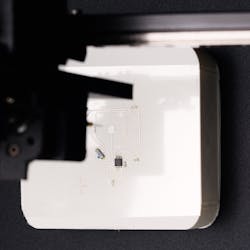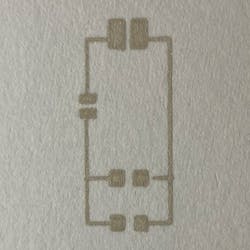Q&A: Exploring the Future of Multi-Material 3D Printing
Emergent technologies are advancements that can change the way we work and live. Additive manufacturing and 3D printing are among the emergent technologies in the machine design space. To go a step further, multi-material 3D printing is an emergent technology within the additive manufacturing space.
Multi-material additive manufacturing is at the forefront of innovation, with markets such as wearables, sensors, batteries and solar cells benefiting from the technology. 3D printing is no longer limited to creating static or passive objects; it can also result in electronics with dynamic or active properties, including conductivity and magnetism. This opens possibilities for manufacturing applications in smart textiles, biomedical devices and automotive, among others.
Ramsey Stevens, CEO of nano3Dprint, has seen this growth demand firsthand and engineered 3D printers in response to innovative manufacturing needs.
In the following Q&A with Machine Design, Stevens shares his insights on multi-material 3D printing, including its challenges, applications and how he sees it contributing to a range of markets.
Machine Design: Tell me about multi-material 3D printing and how it differs from other 3D printing.
Ramsey Stevens: No longer is multi-material 3D printing just about using different colored filaments; instead, it introduces material diversity by embedding into the design functional inks and pastes, which possess dynamic qualities, including conductivity, magnetism, sensing capabilities and responsiveness to external stimuli.
New multi-material 3D printers can print with viscous inks that contain various building blocks, such as metallic and oxide particles, polymers, hydrogels and functional elastomers. By combining traditional thermoformed plastics with these functional inks and pastes, users can customize devices with composition, structure, properties and functionality to suit their needs. Unlike traditional 3D printing, which typically sticks to one material, this approach enables a much more diverse range of capabilities.
An example is 3D printing wires from conductive pastes or inks directly into a 3D-printed plastic part, where interconnects can be embedded into the structural member of the design, such as the head of a robot or the body of a drone. 3D printing wires in advanced applications and printed electronics saves time and money and yields compact conformal designs. It enables users to seamlessly integrate PCBs, heaters and circuits into larger prints.
MD: What are the benefits of multi-material 3D printing for manufacturers? Researchers? Designers?
RS: Multi-material 3D printing enables manufacturers to incorporate functional materials into everyday devices, leading to the creation of custom devices like wearables, sensors, batteries and solar cells. This customization can conform to space limitations and design constraints, accelerating innovation and research and development while reducing costs.
Researchers benefit from the versatility of multi-material 3D printing by exploring new material combinations and creating complex devices with programmed functionality. It speeds up prototyping and innovation, making it easier to develop new solutions across various fields.
For designers, multi-material 3D printing offers unparalleled design flexibility. It allows the realization of intricate, conformal, integrated designs that were previously challenging to achieve. This technology fosters innovation by removing traditional manufacturing constraints (think supply chain delays, high-volume production requirements, expensive prototypes, etc.) and enabling the creation of highly customized products.
MD: Tell me about the applications for multi-material 3D printing. What does this mean for manufacturing design?
RS: With the adoption of multi-material 3D printing, manufacturers can integrate functional materials directly into common devices. These customized products, like wearables, sensors, batteries and solar cells, can incorporate embedded circuitry while adapting to specific space constraints and design preferences. This has the potential to expedite the processes of prototyping, innovation and research, and open avenues for exploring fresh applications and creative possibilities. Additionally, multi-material additive manufacturing is poised to facilitate the creation of smaller-scale objects, intricate geometries and more conformal features.
Another advantage of 3D printing with functional materials is that it can create electronics with low cost and minimal environmental impact. Compared to traditional methods of manufacturing electronics, 3D printing with conductive paste can reduce the amount of material waste and energy consumption. It can also enable users to design and produce electronics on demand without needing expensive and specialized equipment or facilities.
MD: What are the challenges of multi-material 3D printing and how can they be overcome?
RS: Additive manufacturing is a rapidly evolving industry with new applications introduced regularly. While multi-material 3D printing holds immense promise, some of the obstacles include ensuring material compatibility, enhancing printer accessibility and reliability, and managing post-processing demands.
To tackle these challenges head-on, engineers and researchers are actively delving into material development, constantly researching and innovating to create new materials that seamlessly work with multi-material production methods. New commercially available multi-material printers are accelerating the adoption of this technology and accelerating innovation.
MD: How will multi-material printing contribute to the growth of healthcare, automotive and consumer technology markets?
RS: Multi-material 3D printing boasts a wide array of practical applications across various industries. Within all these markets, engineers and designers can prototype and test their ideas in a day. This accelerates innovation, research and development, and enables the discovery of new applications and possibilities.
In healthcare, multi-material printing excels in crafting patient-specific anatomical models, wearable electronics-equipped implants and prosthetics, precision sensors and drug delivery systems. For example, embedded sensors in casts and braces enable continuous patient monitoring, while direct sensor placement on living tissue provides real-time data for treatment decisions. This advances the field of personalized medicine and contributes to substantial cost savings in healthcare.
In the automotive sector, multi-material 3D printing can help enhance vehicle safety and fuel efficiency. This type of additive manufacturing can create electronics with high performance and durability. Fabricating lightweight-yet-robust components embedded with sensors streamlines supply chains, reduces costs and minimizes waste within the automotive industry.
Additionally, in consumer technology, multi-materials 3D printing grants designers the creative freedom to fashion bespoke wearables, sensors and energy storage devices. Multi-material 3D printing is more economical for small consumer tech companies, as it can yield smaller production volumes. It helps designers expand their range of what’s possible and empowers them to stay ahead of the curve.
MD: Anything else you would like to add?
RS: The potential of 3D printing functional materials is enormous. It could revolutionize engineering, science and manufacturing by enabling the creation of novel and innovative electronics with unprecedented features and functionalities.
Additionally, the development of functional inks has exponentially increased in recent years. New ink formulations and newly accessible, commercially available multi-materials 3D printers are accelerating innovation. With multi-material printing combining structural, functional, electronic and even biological elements, it could be argued that we are already in the early days of being able to print virtually anything.
About the Author
Sharon Spielman
Technical Editor, Machine Design
As Machine Design’s technical editor, Sharon Spielman produces content for the brand’s focus audience—design and multidisciplinary engineers. Her beat includes 3D printing/CAD; mechanical and motion systems, with an emphasis on pneumatics and linear motion; automation; robotics; and CNC machining.
Spielman has more than three decades of experience as a writer and editor for a range of B2B brands, including those that cover machine design; electrical design and manufacturing; interconnection technology; food and beverage manufacturing; process heating and cooling; finishing; and package converting.
Email: [email protected]
LinkedIn: @sharonspielman
Facebook: Machine Design
YouTube: @MachineDesign-EBM





